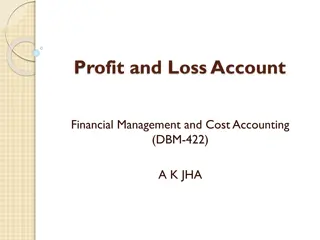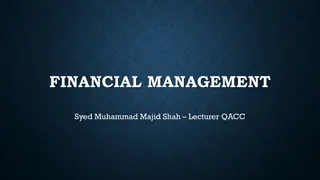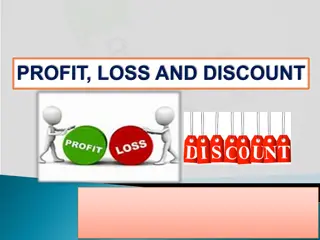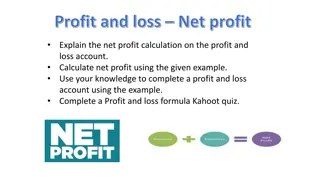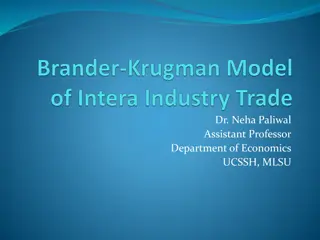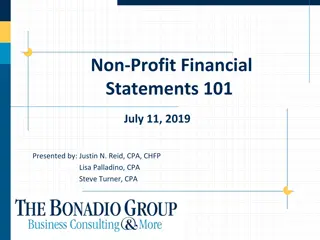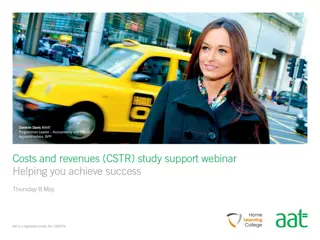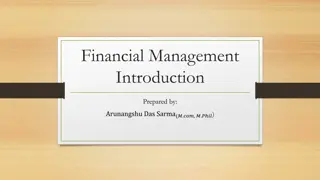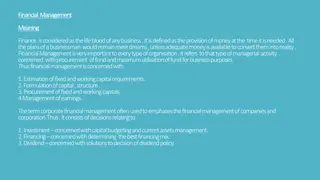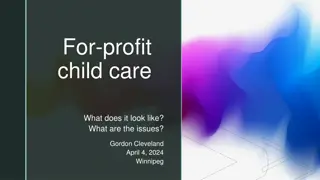Financial Decision Making in Agriculture: Strategies for Profit Maximization
Explore the key principles of financial decision-making in agriculture, focusing on estimating financial implications, Doc White's 3 rules of finance, and analyzing the cost-benefit of spending on feed for milk production. Learn how to utilize partial budgets to assess profitability and make informed choices to enhance farm performance and profitability.
Download Presentation

Please find below an Image/Link to download the presentation.
The content on the website is provided AS IS for your information and personal use only. It may not be sold, licensed, or shared on other websites without obtaining consent from the author. Download presentation by click this link. If you encounter any issues during the download, it is possible that the publisher has removed the file from their server.
E N D
Presentation Transcript
Dr. Alex Doc White Virginia Tech Dairy Science DocWhite@vt.edu
Dr. Alex Doc White Virginia Tech Dairy Science DocWhite@vt.edu
Estimating financial implications Cash flow vs profitability What is a partial budget? How do they work Examples
Doc Whites 3 Rules of Finance You have to give up something to get something Opportunity Cost You have to give up something to get something 1) 1) If it costs more than it s worth, don t do it Marginal Cost > Marginal Revenue If it costs more than it s worth, don t do it 2) 2) Just because you can pay for it doesn t mean you can afford it Don t focus on the purchase price, look at the annual costs Just because you can pay for it doesn t mean you can afford it 3) 3)
Would you spend: $100,000 more in feed to get $80,000 more in milk/yr? $100,000 less on feed and get $80,000 less in milk/yr?
Would you spend: $100,000 more in feed to get $80,000 more in milk/yr? No No you are reducing profits by $20,000/ you are reducing profits by $20,000/yr yr! ! $100,000 less on feed and get $80,000 less in milk/yr?
Would you spend: $100,000 more in feed to get $80,000 more in milk/yr? No No you are reducing profits by $20,000/ you are reducing profits by $20,000/yr yr! ! $100,000 less on feed and get $80,000 less in milk? Yes, you are increasing profits by $20,000! Yes, you are increasing profits by $20,000!
Yup, it sure can For each of your recommendations: Determine if it will cost more than it s worth Your best friend is a partial budget Shows the change in profit change in profit due to your recommendation Shows if the farm will be better off better off than it is currently
Tool for analyzing the change in profit Due to a change in the operation Are you better off than before? Only considers things that change Don t need all that other information! Format to help decide Format to help decide if it costs more than it s worth if it costs more than it s worth
Will a maternity pen help profits? Should I hire more (less) milkers? Should I change my ration? Are custom heifer growers better than raising the heifers yourself? Should I change my heat detection system?
Start with a hypothetical partial budget Forget the numbers for now Forget the numbers for now List the production factors that will change We can milk faster , preg rate will increase Ignore the stuff that doesn t change Figure out where these things fit on the budget Which section of the budget? Then, start hanging dollars on each item
Two financial sides to your recommendation Good Side Added Revenues More milk being produced Higher milk price due to quality Adding a new enterprise Good Side ( more cash coming in ) Decreased Expenses Lower use of inputs Reducing herd size, etc. ( less cash going out )
Two financial sides to any decision Bad Side Reduced Revenues Selling less, or at a lower price Getting rid of an enterprise Bad Side ( less cash coming in ) Added Expenses Increasing use of inputs Adding a new enterprise ( more cash going out )
If the Good Side > Bad Side It s worth more than it costs Profit should increase by making the change If the Good Side < Bad Side It costs more than it s worth Profits will be decreased by making the change
Good Side Added Revenues Good Side Added Revenues Bad Side Reduced Revenues Bad Side Reduced Revenues Reduced Expenses Reduced Expenses Added Expenses Added Expenses A. Total Good Side A. Total Good Side B. Total Bad Side B. Total Bad Side Change in Annual Profit = A. B. =
Clearly state the change you want to analyze I want to add 10 ventilation fans to improve cow comfort I want to add 10 ventilation fans to improve cow comfort List any key assumptions for the change Fans will cost $500 each to purchase The fans will cost $1,450 in utilities & repairs/year Milk production will increase by 2 lbs/cow/day This will increase feed needed Vet costs for cows will drop by $20/cow/year
For each change you identified Put it in the proper section of the partial budget Will this change result in: Added Revenues Added Revenues Decreased Expenses Decreased Expenses Decreased Revenues Decreased Revenues Added Expenses Added Expenses
Purchase and operation of fans 2 lbs/cow/day increase in milk production Extra feed needed Lower vet bills
Purchase and operation of fans Added Expense 2 lbs/cow/day increase in milk production Added Revenue Extra feed needed Added Expense Lower vet bills Reduced Expense
Cost of fans Use the annual Fixed Costs, NOT the purchase price For any asset that will last for more than 1 year Annual Fixed Costs = DITIS Depreciation loss of value (non-cash expense) Cost of fans NOT the purchase price Interest cost of money invested in the asset Taxes property taxes Insurance insurance premiums Shelter value of storing machinery inside .
Docs Annual Fixed Cost estimates: Breeding Livestock Machinery & Equipment Buildings & Facilities 10-15% of purchase price 20-25% of purchase price 5-15% of purchase price
Good Side Added Revenues Milk Production Reduced Expenses Vet Costs Good Side Bad Side Reduced Revenues Added Expenses B. Total Bad Side Bad Side None Fan Operating Costs Fan Fixed Costs Added Feed A. Total Good Side Change in Annual Profit = A B =
Use units that make sense be consistent!! Per year Per year, per cwt, per cow, per month, etc. Only include items that will change Ignore the factors that aren t affected Beware of netting out changes Easy to make mistakes Ex: Milk price increases from $17.50 to $18.50/cwt If milk production also changes, price changes for every cwt!!
For purchased assets with a life > 1 year Include annual overhead expenses (DITIS), NOT the purchase price Do NOT include the loan payments or salvage value When in doubt, be conservative Understate your revenues, overstate your expenses Show your formulas on your budget Reminds you how you did it Shows the judges what you did
Use your production knowledge Total feed needed Lbs feed/cow-day x number of cows x days . Total pounds of milk produced Total hours of labor . Support your calculations Sources of information Benchmarks
Multiply by the appropriate prices or costs Feed = cost of ration/day or /heifer or /lb feed Lbs fed/day x Days x Feed Cost (AF)/lb . Milk = expected milk price/cwt Labor = cost of labor/hour NOTE: Use the COST/hr, not the CASH WAGE/hr FICA, FUTA, SUTA, and benefits
Purchase 10 New Fans Operating Cost = $1,450/year Fixed Cost = 10 fans x $500/fan x 15% = $750/year 15% is the Fixed Cost estimate (DITIS) List these in the Added Expense section
Good Side Added Revenues Milk Production Good Side Bad Side Reduced Revenues Added Expenses B. Total Bad Side Bad Side None Reduced Expenses Vet Costs Fan Operating Costs $1,450 Fan Fixed Costs Added Feed $750 A. Total Good Side Change in Annual Profit = A B
2 lbs/cow/day more milk (500 lactating cows) 2 lbs/cow/day x 365 days = 730 lbs/cow/year 730 lbs/cow/yr x $0.20/lb x 500 cows = $73,000/year Use the mailbox price to account for hauling, etc. List in the Added Revenue section
Good Side Added Revenues Milk Production Good Side Bad Side Reduced Revenues Added Expenses B. Total Bad Side Bad Side $73,000 None Reduced Expenses Vet Costs Fan Operating Costs $1,450 Fan Fixed Costs Added Feed $750 A. Total Good Side Change in Annual Profit = A B
Added Feed to support the added milk Note everyone argues about this! I stay conservative and add it as an added expense 2 lbs milk = 2 lbs feed (as-fed) (Assumes ~50% DM) 2 lbs feed/cow/day x 365 days x 500 cows = 365,000 lbs/ yr 365,000 lbs feed/yr x $0.10/lb (as-fed) = $36,500/year List this as an Added Expense
Good Side Added Revenues Milk Production Good Side Bad Side Reduced Revenues Added Expenses B. Total Bad Side Bad Side $73,000 None Reduced Expenses Vet Costs Fan Operating Costs $1,450 Fan Fixed Costs Added Feed $750 $36,500 A. Total Good Side Change in Annual Profit = A B
$20/cow/yr lower vet costs $20/cow/year x 500 cows = $10,000/year List this as a Reduced Expense List this as a Reduced Expense
Good Side Added Revenues Milk Production Good Side Bad Side Reduced Revenues Added Expenses B. Total Bad Side Bad Side $73,000 None Reduced Expenses Vet Costs $10,000 Fan Operating Costs $1,450 Fan Fixed Costs Added Feed $750 $36,500 A. Total Good Side Change in Annual Profit = A B
Make sure ALL of your units are the same In this case everything is on a per-year basis Total all of the Good Side Total all of the Bad Side Net Change in Profit = Good Side Bad Side
Good Side Added Revenues Milk Production Good Side Bad Side Reduced Revenues Added Expenses B. Total Bad Side Bad Side $73,000 None Reduced Expenses Vet Costs $10,000 Fan Operating Costs $1,450 Fan Fixed Costs Added Feed $750 $36,500 $38,700 A. Total Good Side $83,000 Change in Annual Profit = $44,300 > $0 ($83,000 - $38,700 = $20,000)
If the Change in Profit > $0 Annual profits should increase by making the change This does NOT mean you are making profits It means, at worst, your losses are decreasing It does NOT mean this change is the BEST change It simply analyzes the profitability of one specific change If Change in Profit > $0, it s generally a good move Assuming it will cash flow Can you make the loan payments?!
By adding the new fans Under these assumptions The farm can generate $44,300/year in ADDITIONAL PROFITS from their current situation The farm can generate $44,300/year in ADDITIONAL PROFITS from their current situation The $44,300 is economic profit It doesn t represent the change in cash flow It doesn t include any loan payments Some of the Fixed Costs may be non-cash expenses
Life isnt all about finances and profits Sometimes other factors will sway your decision Examples: Less headaches for management or employees Improved quality of the job No service or parts in the area Compatibility with other equipment/services
Adding New Fans Is your labor capable of maintaining the fans? Aiming, turning on/off, repairing Direction of fan airflow vs natural airflow? Change in milk quality? Is extra feed available? Purchase, producing, storage
Adding New Fans Will bulk tank hold the extra milk? Do you have the cash available to purchase & run the fans? Look at Balance Sheet (cash & savings) Are loans available if needed? Impact on milk quality (lower SCC)? May change your milk price! Other?
Provides valuable information to management Minimum performance needed Minimum milk price Minimum milk yield Maximum purchase cost for inputs Helps wrap your brain around the numbers Puts it in terms that are easier to understand
Breakeven Change in Daily Milk Production Holding ALL else constant That includes the added feed for milk production (Milk Revenue Change Net Change in Profit) (Milk Price/cwt x Number of Cows) = Again, this assumes all else remains constant
Breakeven Change in Daily Milk Production (Milk Revenue Change Net Change in Profit) (Milk Price/cwt x Number of Cows) = ($73,000 - $44,300) / ($20/cwt x 500 cows) = 287 lbs/cow/yr in added milk = 287 lbs/cow/yr / 365 days = 0.8 lbs/cow/day Again, this assumes all else remains constant
To get a handle on uncertainty 10-25% change in key factors Typically, do these one at a time Examples: 20% increase in feed expenses 10% decrease in expected milk production 15% increase in vet costs
Partial budgets a structured framework Helps you logically think through the change Start with the production stuff you know & like! Then estimate the dollars involved BE & Sensitivity analysis provide more power In combination with partial budgets At a minimum Will impress the ag lender and the farmer judges!
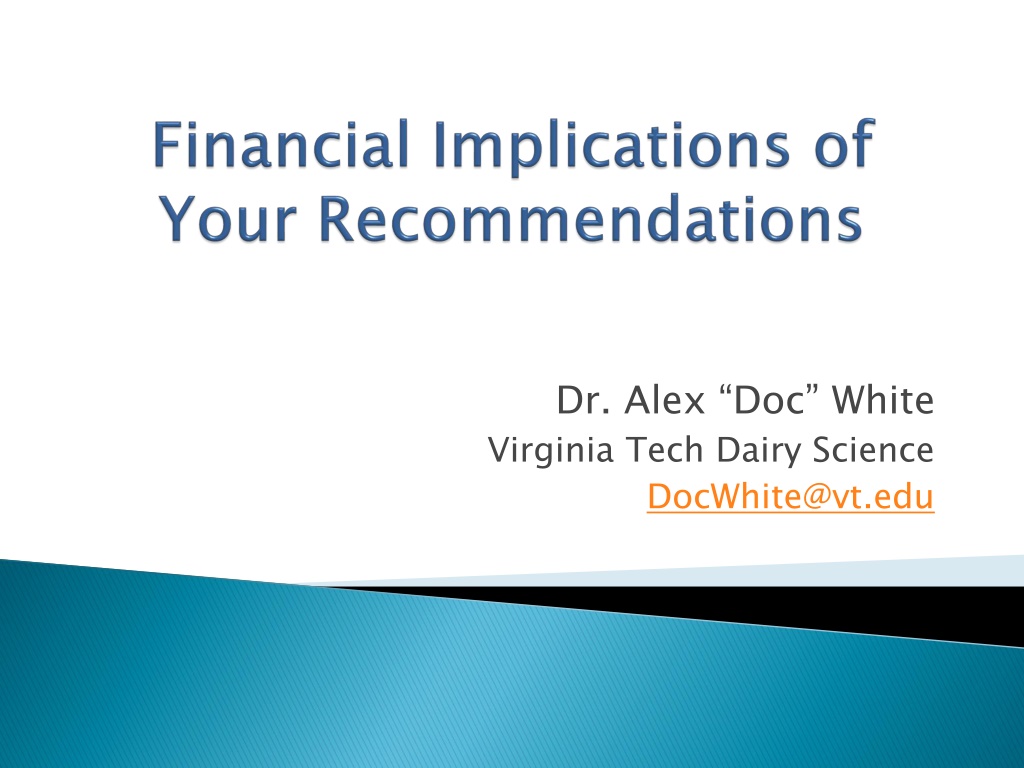
 undefined
undefined

 undefined
undefined






